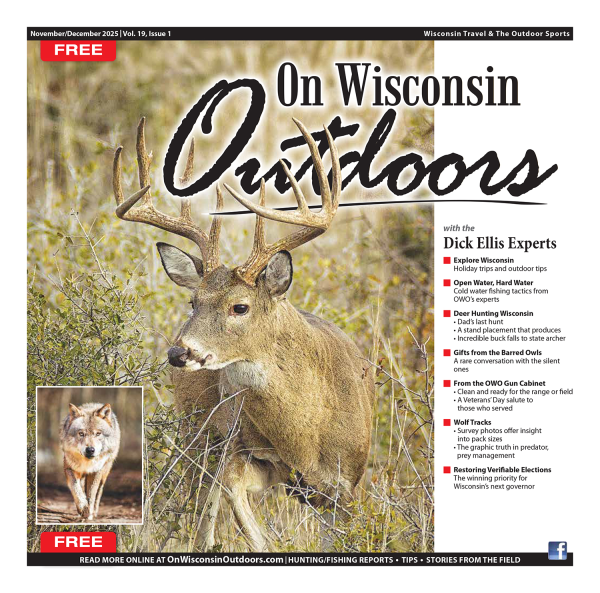A DIFFERENT HUNT...Wild fall mushrooms still provide search, table fare
By Dick Ellis
Reader Note: This trip took place in 2006 and includes field time in both Crawford County and Rock County. Crawford County offers fabulous hunting and fishing opportunities along with superior scenery. For lodging, dining and information for hunting and fishing trips, connect with the Ferryville Tourism Council and Executive Director Sherry Quamme at visitferryville.com, 608-734-9077 or squamme@centurytel.net.
Resting with my back against an ancient oak in prime Crawford County turkey country October 8, the stalk had been successful but apparently the hunt would not be. After working to locate birds and then patiently moving to a good ambush point, several large gobblers were moving away from the stand, gorging in the alfalfa on an immense insect hatch in the unseasonably warm October sunshine.
Just inside the woodline, several puffballs; wild fall mushrooms as large as volleyballs were visible on the forest floor among the immature oak and thorny scrub brush. The slightly yellowed coloration and deteriorating condition of the fungi said that the mushrooms had not been edible for perhaps a week or so. Another disappointment.
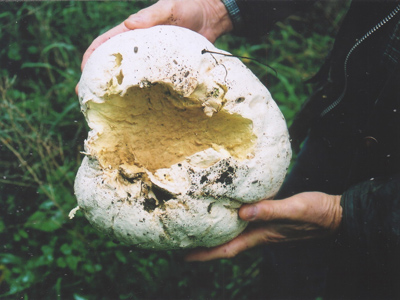 |
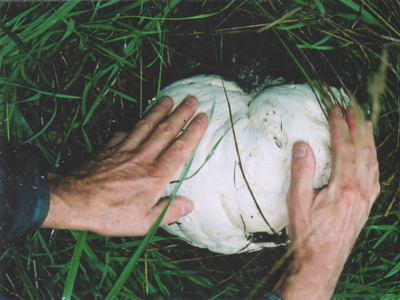 |
| Found too late, these large puff balls; wild mushrooms that grow throughout Wisconsin during fall months, had progressed past the prime edible stage. | |
Autumn hunts have evolved far beyond the excitement found by man in placing his strategy in the field against Wisconsin game. That thrill remains. But simplistically stated, I want the freezer full. Table fare provided by turkey, venison, other upland birds and waterfowl and more recently, wild fall Wisconsin mushrooms is in itself worth the time, effort…and fun of the harvest.
Like the highly sought after wild morels of spring, Wisconsin offers Fall wild mushroom species that in this reporter’s opinion are more desirable on the palette than store bought varieties. Following recent autumn rains that stimulate extraordinary mushroom growth, Wisconsin naturalist Bob Swann led me on a search for edible and common fall species that include puffballs, leafy polyporous, sulphus polyporous, shaggy mane, ink cap, and honey mushroom.
“First and foremost, do not eat any wild mushrooms without positively identifying it from a book,” Swann said. “Even with a book an amateur should never pick and eat any stemmed (possibly poisonous) variety without consulting an expert.”
According to Swann, fall mushroom growth is stimulated with heavy rains that are common in late August through September with productive hunting for the edible fungus continuing into approximately the first two weeks of October. Although often hidden by tall grasses, the large size and light coloration of wild mushrooms like puffballs make discovery for the mushroom hunter very likely. “From my own experience over the years I also know where to look,” Swann said.
Swann lead us to several areas in Rock County that have been annual producers of wild mushrooms. Mushrooms like the “choice” leafy polyporous we would find on this wet afternoon, he said, will for example grow annually at the base of the same oak tree until the nutrition is depleted from the roots of that tree.
Swann said he also learned the hard way never to harvest the entire mushroom, but to leave some for seed. A very productive stump system would have produced fine eating for years had not Swann in his early years of wild mushroom hunting taken the entire specimen, leaving nothing for regeneration. Today, leaving some for tomorrow is the rule.
“Leafy polyporous are always found on the ground against the trunk of an oak or up to several feet away from the tree,” Swann said, looking at one specimen that would require two hands to carry. “This mushroom will very quickly grow to three times as large as it is right now. But the risk of not taking part of this to eat right now is that wildlife might eat it. I’m going to leave it and play the odds that the deer won’t find it.”
According to Simon and Schuster’s Guide to Mushrooms, the leafy polyporous is one of the largest fungi, weighing as much as 25 pounds and is among the most popular autumn edibles. Often referred to as “Hen-of-the-woods”, according to the book, the mushroom “somewhat” resembles a small hen and is found covered with leaves growing at the base of living oaks.
If the leafy polyporous is among the largest wild mushrooms, the giant puffballs Swann would also find in numbers during our search surely stand in a class of their own. According to Simon and Schuster, puffballs, considered excellent as table fare when “young”, can reach weights of 56 pounds. Our puffballs weighed an estimated three or four pounds and measured about 12 inches in diameter. Most were also passed prime as an edible mushroom, with yellowing coloration and deteriorating texture. Swann did find one large, pure white and firm puffball that would serve as our test lunch.
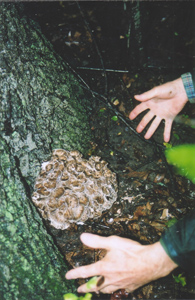 |
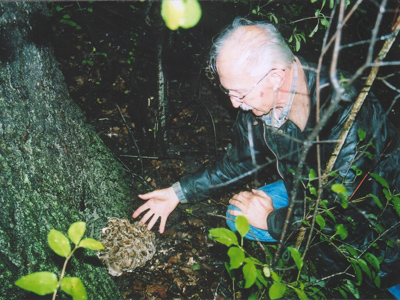 |
| Considered a choice find by wild fall mushroom hunters, this Leafy Polyporous was found by naturalist Bob Swann at the base of an oak tree. Swann had to decide whether to allow the mushroom to grow even larger before harvesting it to eat. If he did, he would risk losing the delicacy to deer and other wildlife. | |
According to Common Edible Mushrooms by Clyde M. Christensen, all above-ground puffballs are safe and good to eat “and believed by many to be superior to any other edible fungi. They must be picked while still solid and white inside and should be examined fairly carefully for the presence of maggots.”
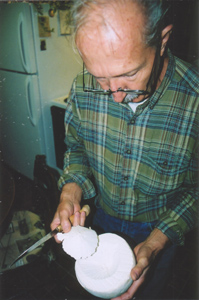 |
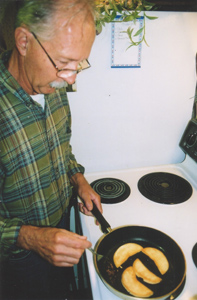 |
| A puffball in perfect condition for eating; a wild mushroom found through Wisconsin during the fall months, is prepared by Naturalist Bob Swann in his kitchen. | |
The puffball Swann prepared was pure white inside and out and extremely firm without the presence of any “maggots” that no doubt has already led some readers to conclude that they will look no further than domestically raised mushrooms. An open mind and some precaution, though, are all that’s necessary for unique, fine dining.
“Only use puffball specimens five inches or larger to avoid the button stage that can be confused with stemmed varieties that can be poisonous,” Swann said. “Use puffballs that are pure white outside and inside, skin it, slice thin one-quarter inch to three-eighths inch and pan fry in butter.”
Our meal of puffball, a wild Wisconsin mushroom was excellent; as good as the morels of spring and our “hunt” a success. Such fine dining serves as a pleasant reminder that there is much more to the hunt than the strategies of the field.
And serves as a personal reminder too, that a return to Crawford County will hopefully put Tom on the table next.
